私服
私服
1 私服的安装和启动
公司在自己的局域网内搭建自己的远程仓库服务器,称为私服,私服服务器即是公司内
部的 maven 远程仓库,每个员工的电脑上安装maven 软件并且连接私服服务器,员工将自
己开发的项目打成 jar 并发布到私服服务器,其它项目组从私服服务器下载所依赖的构件
(jar)。
私服还充当一个代理服务器,当私服上没有jar 包会从互联网中央仓库自动下载,如下
图: 
2.下载 nexus
Nexus 是 Maven 仓库管理器,通过 nexus 可以搭建 maven 仓库,同时 nexus 还提供强
大的仓库管理功能,构件搜索功能等。
下载Nexus, 下载地址:http://www.sonatype.org/nexus/archived/
解压如图所示:
cmd 进入bin 目录,执行nexus.bat install 如图所示:
安装成功在服务中查看有nexus 服务: 
卸载打开cmd 进入nexus 的bin 目录,执行:nexus.bat uninstall 。如图所示:
3.启动 nexus
方法1:
cmd 进入bin 目录,执行nexus.bat start 如图所示:
方法2:
直接启动nexus 服务,如图所示:
![]()
查看nexus 的配置文件conf/nexus.properties 如图所示:
里面配置解释如下:
# Jetty section
application-port=8081 # nexus 的访问端口配置
application-host=0.0.0.0 # nexus 主机监听配置(不用修改)
nexus-webapp=${bundleBasedir}/nexus # nexus 工程目录
nexus-webapp-context-path=/nexus # nexus 的web 访问路径
# Nexus section
nexus-work=${bundleBasedir}/../sonatype-work/nexus # nexus 仓库目录
runtime=${bundleBasedir}/nexus/WEB-INF # nexus 运行程序目录
通过浏览器访问http://localhost:8081/nexus/,结果如图所示:
使用Nexus 内置账户admin/admin123 登陆:
点击右上角的Log in,输入账号和密码 登陆 如图所示:
登录成功,如图所示:
查看nexus 的仓库如图所示:
nexus 的仓库有4 种类型如图所示: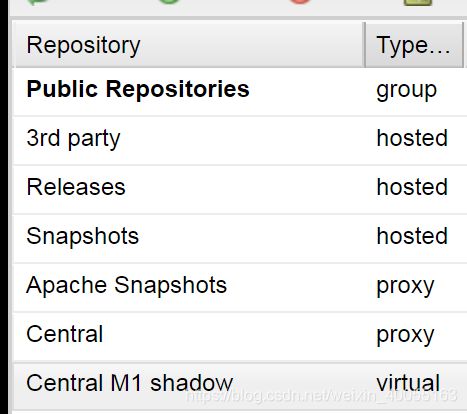
- hosted,宿主仓库,部署自己的 jar 到这个类型的仓库,包括 releases 和 snapshot 两部
分,Releases 公司内部发布版本仓库、 Snapshots 公司内部测试版本仓库。 - proxy,代理仓库,用于代理远程的公共仓库,如 maven 中央仓库,用户连接私服,私
服自动去中央仓库下载jar 包或者插件。 - group,仓库组,用来合并多个hosted/proxy 仓库,通常我们配置自己的maven 连接仓
库组。 - virtual(虚拟):兼容Maven1 版本的jar 或者插件。
nexus 仓库默认在sonatype-work 目录中,如图所示:
central:代理仓库,代理中央仓库,如图所示: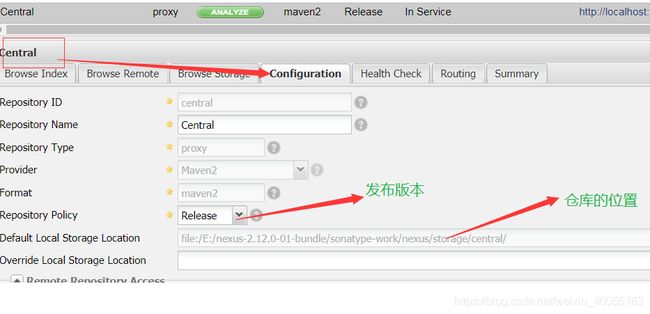
apache-snapshots:代理仓库
存储snapshots 构件,代理地址https://repository.apache.org/snapshots/
central-m1:virtual 类型仓库,兼容Maven1 版本的jar 或者插件
releases:本地仓库,存储releases 构件。
snapshots:本地仓库,存储snapshots 构件。
thirdparty:第三方仓库。
public:仓库组。
2 私服的应用
2.1 需求
企业中多个团队协作开发通常会将一些公用的组件、开发模块等发布到私服供其它团队
或模块开发人员使用。
本例子假设多团队分别开发 maven_day02_dao、maven_day02_service、maven_day02_web,某个团队开发完在maven_day02_dao会将maven_day02_dao发布到私服供ssm_service 团队使用,本例子会将maven_day02_dao 工程打成jar 包发布到私服。如图所示:
2.2 配置
第一步:需要在客户端即部署maven_day02_dao 工程的电脑上配置 maven 环境,并修改 settings.xml 文件,配置连接私服的用户和密码 。
此用户名和密码用于私服校验,因为私服需要知道上传的账号和密码是否和私服中的账号和
密码一致。代码如下:
<server>
<id>releases</id>
<username>admin</username>
<password>admin123</password>
</server>
<server>
<id>snapshots</id>
<username>admin</username>
<password>admin123</password>
</server>
配置如图所示:
releases 连接发布版本项目仓库。
snapshots 连接测试版本项目仓库。
如图所示:

第二步: 配置项目pom.xml
配置私服仓库的地址,本公司的自己的jar 包会上传到私服的宿主仓库,根据工程的版本号
决定上传到哪个宿主仓库,如果版本为 release 则上传到私服的 release 仓库,如果版本为
snapshot 则上传到私服的snapshot 仓库。代码如下:
<distributionManagement>
<repository>
<id>releases</id>
<url>http://localhost:8081/nexus/content/repositories/releases/</url>
</repository>
<snapshotRepository>
<id>snapshots</id>
<url>http://localhost:8081/nexus/content/repositories/snapshots/</url>
</snapshotRepository>
</distributionManagement>
注意:pom.xml 这里 和 settings.xml 配置 对应! 如图所示:
2.3 测试
将项目dao 工程打成jar 包发布到私服:
1、首先启动nexus。
2、对maven_day02_dao工程执行deploy命令。如图所示:
根据本项目pom.xml中version定义决定发布到哪个仓库,如果version定义为snapshot
执行deploy 后查看nexus 的snapshot 仓库,如果version 定义为release 则项目将发布到nexus的release 仓库,本项目将发布到snapshot 仓库。如图所示:上面上传成功!
也可以通过http://localhost:8081/nexus/content/repositories/snapshots/com/txw/maven_day02_dao/1.0-SNAPSHOT/方式查看,如图所示: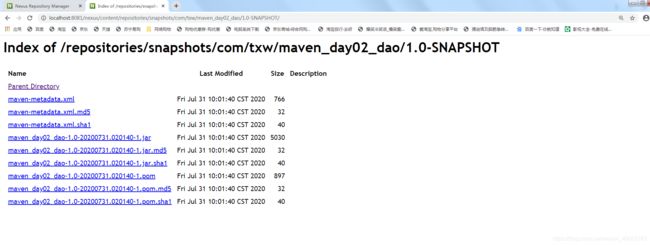
2.4 从私服下载 jar 包
没有配置nexus 之前,如果本地仓库没有,去中央仓库下载,通常在企业中会在局域网
内部署一台私服服务器,有了私服本地项目首先去本地仓库找 jar,如果没有找到则连接私
服从私服下载 jar 包,如果私服没有 jar 包私服同时作为代理服务器从中央仓库下载 jar 包,这样做的好处是一方面由私服对公司项目的依赖jar 包统一管理,一方面提高下载速度,项
目连接私服下载jar 包的速度要比项目连接中央仓库的速度快的多。
本例子测试从私服下载maven_day02_dao工程jar 包。
下载之前如图所示,删除,重新下载:
找到maven_day02_web选择tomcat7.run。跑一下,如图所示: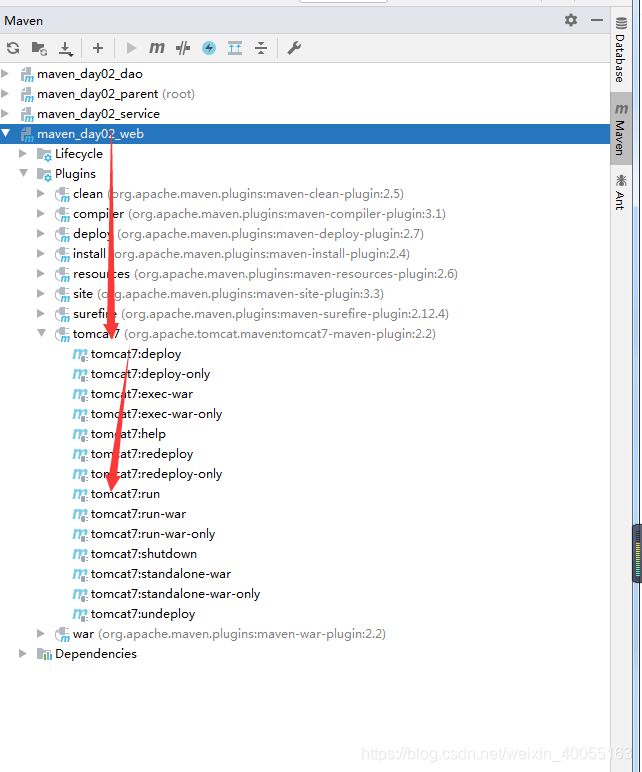
运行完之后,会如图所示的错误!
说明找不到service,接下来,为了验证dao是否能安装,先运行service安装,如图所示:
如图所示:说明service安装成功!
找到maven_day02_web选择tomcat7.run。跑一下,如图所示: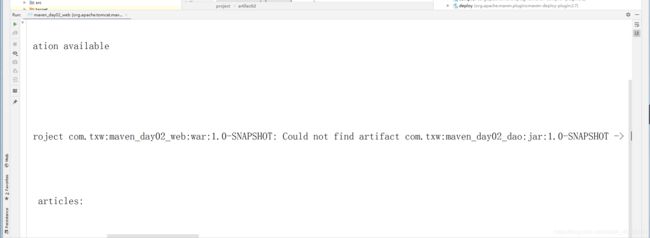
说明找不到dao的依赖jar包,需要配置如下的代码:
<!-- 下载jar包配置 -->
<profile>
<!--profile的id -->
<id>dev</id>
<repositories>
<repository> <!--仓库id,repositories可以配置多个仓库,保证id不重复 -->
<id>nexus</id> <!--仓库地址,即nexus仓库组的地址 -->
<url>http://localhost:8081/nexus/content/groups/public/</url> <!--是否下载releases构件 -->
<releases>
<enabled>true</enabled>
</releases> <!--是否下载snapshots构件 -->
<snapshots>
<enabled>true</enabled>
</snapshots>
</repository>
</repositories>
<pluginRepositories> <!-- 插件仓库,maven的运行依赖插件,也需要从私服下载插件 -->
<pluginRepository> <!-- 插件仓库的id不允许重复,如果重复后边配置会覆盖前边 -->
<id>public</id>
<name>Public Repositories</name>
<url>http://localhost:8081/nexus/content/groups/public/</url>
</pluginRepository>
</pluginRepositories>
</profile>
激活的代码如下:
<activeProfiles>
<activeProfile>dev</activeProfile>
</activeProfiles>
如图所示:
找到maven_day02_web选择tomcat7.run。跑一下,如图所示:说明可以私服上下载dao的jar包下载成功!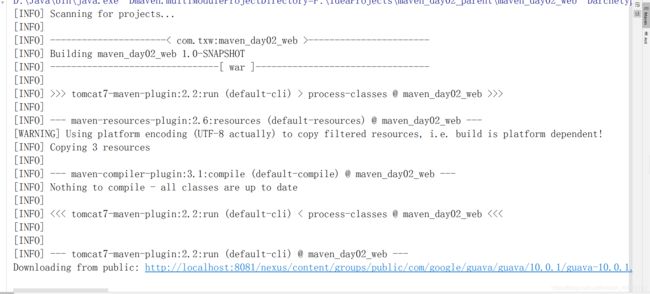
2.5 把第三方 jar 包放入本地仓库或私服
1.导入本地仓库
随便找一个 jar 包测试,可以先 CMD 进入到 jar 包所在位置,运行的命令如下:
mvn install:install-file -DgroupId=com.alibaba -DartifactId=fastjson -Dversion=1.1.37 -Dfile=fastjson-1.1.37.jar -Dpackaging=jar
如图所示:说明下载成功!
2.打开cmd直接运行的命令如下:
mvn install:install-file -DgroupId=com.alibaba -DartifactId=fastjson -Dversion=1.1.37 -Dpackaging=jar -Dfile=C:\Users\Administrator\Desktop\安装第三方jar包\fastjson-1.1.37.jar
运行结果如图所示:
如图所示:说明下载成功!
2. 导入私服
需要在maven 软件的核心配置文件settings.xml 中配置第三方仓库的server 信息。配置代码如下:
<server>
<id>thirdparty</id>
<username>admin</username>
<password>admin123</password>
</server>
mvn deploy:deploy-file -DgroupId=com.alibaba -DartifactId=fastjson -Dversion=1.1.37 -Dpackaging=jar -Dfile=fastjson-1.1.37.jar -Durl=http://localhost:8081/nexus/content/repositories/thirdparty/ -DrepositoryId=thirdparty
mvn deploy:deploy-file -DgroupId=com.alibaba -DartifactId=fastjson -Dversion=1.1.37 -Dpackaging=jar -Dfile=C:\Users\Administrator\Desktop\安装第三方jar包\fastjson-1.1.37.jar -Durl=http://localhost:8081/nexus/content/repositories/thirdparty/ -DrepositoryId=thirdparty
运行结果如图所示:
如图所示:说明下载到私服成功!
3. 参数说明
DgroupId 和DartifactId 构成了该 jar 包在 pom.xml 的坐标,项目就是依靠这两个属性定位。
自己起名字也行。
Dfile 表示需要上传的jar 包的绝对路径。
Durl 私服上仓库的位置,打开nexus——>repositories 菜单,可以看到该路径。
DrepositoryId 服务器的表示id,在nexus 的configuration 可以看到。
Dversion 表示版本信息,
关于jar 包准确的版本:
包的名字上一般会带版本号,如果没有那可以解压该包,会发现一个叫 MANIFEST.MF 的文件,这个文件就有描述该包的版本信息。
比如Specification-Version: 2.2 可以知道该包的版本了。
上传成功后,在nexus 界面点击3rd party 仓库可以看到这包。

